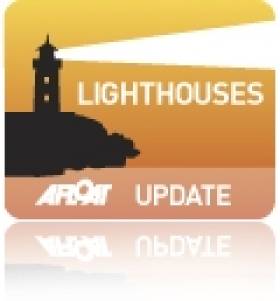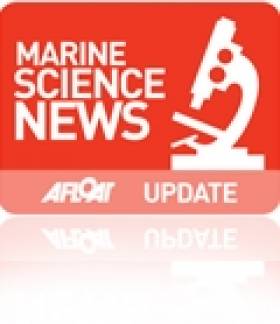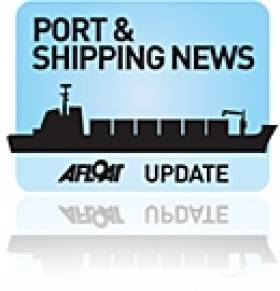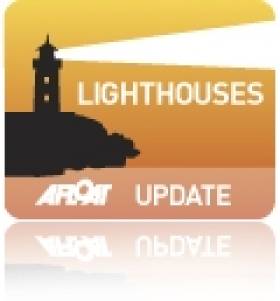Displaying items by tag: Arklow Marine Services
Modification Work for Irish Lights Aids to Navigation Vessel
#LighthouseTender – The Commissioners of Irish Lights ILV Granuaile (2000/2,625grt) an aids to navigation tender vessel, is undergoing steel modification works while berthed in Dublin Port, writes Jehan Ashmore.
Work on the 79m long tender which is moored at Sir John Rogersons' Quay close to the East-Link Bridge, is been carried out by Arklow Marine Services.
The work involves fabricating of a new radar mast, installation of calorifier units and modifications to the bridge.
Steel work modifications entail fitting under deck strengthening in way of ROV pads which are to be in accordance and to the approval of Lloyds.
Killybeg based Barry Electronics are supplying and fitting a new radar which requires a new mast with existing steelwork and platform being removed.
The new calorifier unit which is to replace existing plant will be piped in using 316 stainless steel pipe materials. It is expected the quayside work be completed by the middle of this month.
ILV Granuaile is the third tender to carry the name of the famous Mayo pirate Queen.
She was built by the Damen Shipyards Group, where the hull and superstructure were completed in Romania in Galati, the largest port town on the River Danube.
Following launching, she was towed through the Black Sea to the Netherlands for fitting out at another Damen shipyard, where work included the installation of electronic equipment.
Research Vessel Speeds Home following Modification Work
#ResearchVessel – The Geological Survey of Ireland (GSI) research vessel Keary, returned to her homeport of Dun Laoghaire Harbour today, having completed modifications at Arklow Marine Services, writes Jehan Ashmore.
The South African built aluminium catamaran craft had been hoisted onto the quayside at the Co. Wicklow port so to allow the work to begin.
She made her homebound journey with a high-speed transit through Dalkey Sound, and completed her voyage to the 820-berth Dun Laoghaire marina.
As previously reported on Afloat.ie the RV Keary was joined in October by the former Inland Fisheries Ireland cutter, Cosantóir Bradán. She is employed as part of INFOMAR, the national marine mapping programme, conducted by the GSI and Marine Institute.
Ports & Shipping Review: Manx Route Opens, Toxic Cargo-ship Leak, Replenishment at Sea, Cruise Callers, Ferry Festive Boost, Arklow Newbuild and much more
#PORTS & SHIPPING REVIEW - Over the last fortnight Jehan Ashmore has reported from the shipping scene where the Manx-UK winter operated Douglas-Liverpool (Birkenhead) route resumed service.
The port of Warrenpoint on Carlingford Lough was where 18 people suffered injuries arising from a toxic gas leak onboard Arklow Meadow, a dry-cargsship which had arrived with a cargo of grain.
For the sixth year in succession the Irish Travel Trade News Travel Awards voted Irish Ferries as Best Ferry Operator of the Year 2012.
A new book New Life for churches in Ireland, has been published and in which features the former Mariners' Church of Ireland, Dun Laoghaire, now home of the National Maritime Museum of Ireland.
Coliemore Harbour on Dalkey Sound (the medieval port for Dublin) is to undergo a survey to access structural damage on behalf of Dun Laoghaire-Rathdown County Council.
The Naval Service was kept busy within the first fortnight of this month with the detention of two foreign registered vessels for alleged breaches of fishing regulations off Castletownbere.
In a first for the Commissioners of Irish Lights and the Naval Service, a joint replenishment at sea (RAS) exercise took place involving the ILV Granuaile and coastal patrol vessel CPV L.É.Ciara (P42).
Killybegs based Sinbad Marine Services have put on sale the SMS Coastal Cat, a 12m survey workboat built locally at the Mooney Boats yard.
In 2013, ten cruise calls are scheduled to visit Dun Laoghaire, bringing around 10,000 visitors and where the 148,528 tonnes giant liner Queen Mary 2 is to make an anchorage call in mid-May.
Dutch owned heavy-lift specialist Abis Shipping are seeking professionals and trainees to work for the expanding company which this month is due delivery of newbuild Abis Dublin.
In an unprecedented move Irish Ferries are to add a third vessel between Dublin-Holyhead during Christmas and New Year periods while Stena Line are to bring back HSS fast-craft operations between Dun Laoghaire-Holyhead.
In what will be a third order for a wind-farm support vessel from Gardline UK has gone to Arklow Marine Services, the 19m newbuild is to be completed in July 2013.
Gardline Order Third Newbuild from Arklow Boatbuilders
#NEWBUILD – Gardline Marine UK returned to Arklow Marine Services, having placed an order for a third windfarm service vessel, though on this occasion to a totally new design, writes Jehan Ashmore.
The 19m newbuild is to be constructed with a flexibly mounted deckhouse and wheelhouse in order to reduce noise absorbtion. Work will commence in early January and delivery date is July 2013.
Last June, the boatyard launched Guardian 10 on the River Avoca, this second 20m wind farm transfer service vessel was commissioned for Gardline and Alicat.
As previously reported on Afloat.ie she made her delivery promotional voyage the following month via the North Channel to her homeport of Great Yarmouth.
Currently at the yard is the Geological Survey of Ireland's RV Keary, which is undergoing modifications. She was recently lifted onto the quayside and where work is due to be completed with the vessel scheduled for re-launching early in the New Year.
Merseyside based UK Patrol Boat Berths in Dublin Marina
#NAVY VISIT – The Royal Navy's coastal training patrol boat HMS Charger (P 242) spent last night in Dublin Port having sailed from Liverpool's East Brunswick Dock. The vessel is based at the Commanding Officer of the Liverpool University Royal Naval Unit RN Headquarters on Merseyside, writes Jehan Ashmore.
The small boat measuring 20m in length and a beam of 6m remains this evening moored alongside the Poolbeg Yacht Boat Club Marina. The 100-berth facility faces Alexandra Basin where P&O Cruises Arcadia docked today.
HMS Charger is an Archer P2000 class patrol boat built by Waterfcraft Ltd of Shoreham. She provides practical navigation and seamanship training at sea where a crew recruitment unit takes place annually in early October from the universities in Liverpool and also from Lancaster University.
Last week HMS Charger called to Belfast Lough which included berthing in the city's Abercorn Marina basin next to the Titanic Quarter. Also visiting the basin this week was the newbuild WFSV Gardian 10 completed by Arklow Marine Services which was on a promotional delivery voyage to Great Yarmouth.
Arklow Newbuild’s Link to Former Irish Lights Tender
#FORMER IRISH LIGHTS TENDER -With the Guardian 8 preparing to set sail from her builders homeport of Arklow this month, as previously reported on Afloat.ie, her owners Gardline Marine Services also operate a former Commissioners of Irish Lights tender, writes Jehan Ashmore.
The Great Yarmouth based company operate a multi-purpose fleet which includes the survey vessel Ocean Seeker (PHOTO). She was a familiar sight as the ILV Granuaile (1970/1,943grt) while serving for three decades from the Irish Lights marine depot in Dun Laoghaire Harbour.
Built by Fergusan Brothers of Port Glasgow, she was the last traditional tender for CIL in that her working deck was positioned forward. Apart from the short career of the Gray Seal, the 2000 built successor ILV Granuaile (the third to carry the name of the Mayo pirate queen) was the first custom built tender for CIL to introduce a radical design with an aft end work deck.
Arklow Yard to Launch New Wind Farm Service Vessel
#NEWBUILD NEWS - The first of two 20m windfarm service vessels (WFSV) is to be launched from Arklow Marine Services tomorrow, writes Jehan Ashmore.
The high-speed aluminium newbuild to be named Gardian 8, has been commissioned to service the offshore renewable industry in the UK, and handed over to her clients next month.
In the interim period, the WFSV which is twin-hulled is to take sea-trails before she is officially launched later this month to owners Gardline Group, based in Great Yarmouth.
Gardline have also ordered a sister WFSV, where the frames and longitudinal stiffening of the second newbuild are currently being fitted. She is to join the Gardline fleet with a delivery date in July.
Arklow Marine Services are also working on a 24m steel mooring barge for Bantry Bay Harbour Commissioners. The barge, which has a beam of 6m is scheduled for delivery in April this year.



































































